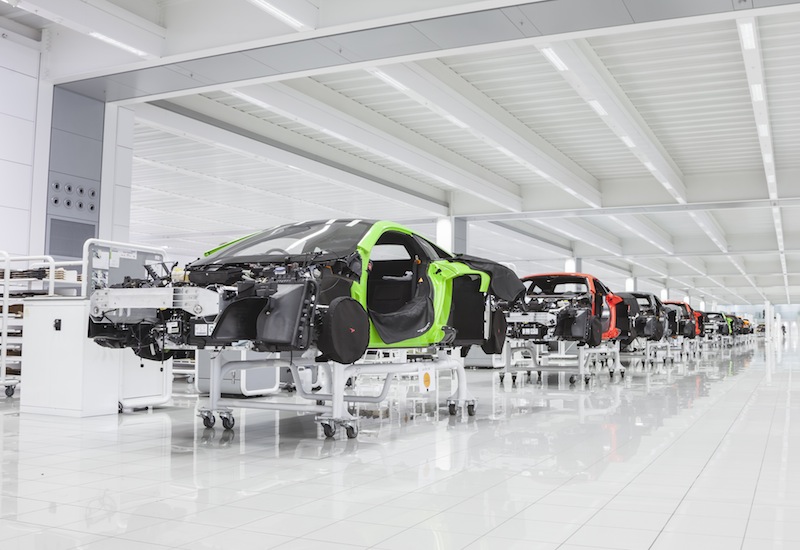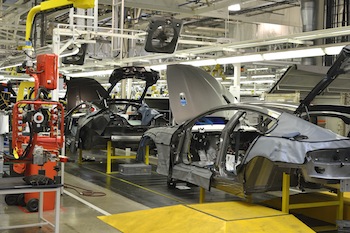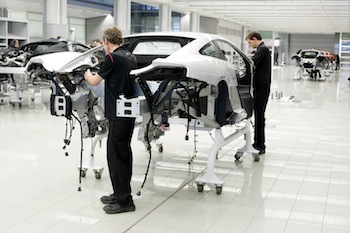As McLaren and Aston Martin both build up their production, AMS takes a magnifying glass inside their spotless factories at Woking and Gaydon respectively to see the latest in high-end carmaking in Britain McLaren Automotive and Aston Martin are both gearing up to double their production as the two luxury companies launch new models. Late last year, AMS went to take a look at their manufacturing facilities, allowing a comparison between the two and providing insights into high-end carmaking in Britain today.
McLaren Automotive and Aston Martin are both gearing up to double their production as the two luxury companies launch new models. Late last year, AMS went to take a look at their manufacturing facilities, allowing a comparison between the two and providing insights into high-end carmaking in Britain today.
The two companies can be placed in the same category because of the following similarities: both are largely independent, both are making cars selling at over £100,000 ($141,000) and both have recently invested in their facilities to bring a new range of models into the market. They are of a similar size too, currently with around 1,500 employees each, although that will soon change at McLaren. And both pride themselves on the lack of automation at their plants – indeed, delight in proclaiming that they only have one robot onsite.
One big difference between them is heritage. Aston Martin has existed for over 100 years, since Robert Bamford and Lionel Martin established their own company in 1913. McLaren Automotive has been building cars only since 2011, after the Woking-based Formula 1 (F1) team decided to spin off a separate business to create a kind of British Ferrari.
McLaren is currently on the up, predicting this year that it will sell around double the 1,654 two-seat supercars which it shifted in 2015. The OEM is confident in this prediction because it has around 1,300 orders for the new Sport Series range, a car which brings the entry price for a McLaren down to £126,000. In preparation, the OEM announced that it will add a second shift at its Woking plant, plus a further 250 jobs, including 200 in production.
“Look at the stitching line; you’ll see a slight wobble. We should celebrate that imperfection that comes from being handmade... [But] everything else has to work perfectly” – Andy Palmer, Aston Martin

By contrast, Aston Martin is in a trough ahead of the long-awaited introduction of the new DB11 two-door coupe at the Geneva Motor Show in March, the first model in the complete refreshment of its sports car range. That vehicle will go on sale in the third quarter of 2016 as a replacement for the ageing DB9, but rather than add jobs, Aston Martin last year announced a cut of 295 personnel, which it has now implemented (the company says that none went from production).
In 2015, Aston Martin sold around 3,500 cars, a long way from its mid-2000s peak of approximately 7,000, when models like the entry V8 Vantage were still fresh. CEO Andy Palmer notes that in its first 100 years, the company went bankrupt seven times. His ‘second century’ plan is to end the boom and bust cycle without relying so much on the sports cars that made Aston’s name.
The company will introduce an SUV in 2019, potentially at a new factory outside the UK – although the rationale for a shift abroad is hard to fathom. Sports-car production would be capped at 7,000 at the Gaydon plant, while output for the SUV would hit 5,000. A saloon to rival Rolls-Royce and Bentley models will also be made after 2018, following the sales launch of the third sports car.
Arguably the most interesting part of AMS’ tour of the Aston Martin plant was the trim shop, which has 30 stations. This is where the all-important leather trimming is completed, not only for seats but other elements of the car too. This is where the human touch is most visible, and CEO Andy Palmer says this fact should be highlighted as an example of the lack of automation in the build process. “Look at the stitching line; you’ll see a slight wobble. We should celebrate that imperfection that comes from being handmade,” he said. However, he added that “everything else has to work perfectly”. Aston Martin uses leather from Scottish supplier Bridge of Weir, and the seat frames come from Recaro.
McLaren’s trim shop, which is underground below the assembly shop, was unavailable during the tour.
Both McLaren and Aston assemble cars rather than manufacture them. No parts are stamped or made; all are brought in. The basis of all McLarens – from the £126,000 540S to the £1m P1 (now discontinued) – is a carbon-fibre tub that creates the central passenger area onto which the front and rear subframes are bolted and body panels are bonded. Known as the Monocell, this is shipped in from Austrian company Carbo Tech and represents the latest in McLaren’s carbon-fibre expertise, which goes back to the 1980s when it started using the material in its F1 cars.
“The first F1 tubs took 6,000 man hours to make, the one for the Mercedes-Benz SLR McLaren [a supercar built from 2003] took 400 hours, these take four man hours. That’s one reason we can bring in the Sports Series at £126,000,” said Amanda McLaren, daughter of founder Bruce McLaren, and a brand ambassador for the company.
Taking the James Bonder approachDespite Aston Martin’s long heritage, the company has only been at Gaydon since 2003, when it was still part of Ford’s Premier Automotive Group. The facility sits next to the engineering centre of Jaguar Land Rover (JLR), another company formerly owned by Ford; Aston’s presence is not appreciated by the rapidly expanding JLR, according to one employee who spoke to AMS.
Ford sold Aston in 2007, and despite JLR’s need for space, Aston Martin is finalising a “multimillion pound” expansion (no figure was mentioned) which enlarges the plant by 10,000 sq.m. The new facilities include an expanded bodyshop and trim shop, as well as a fully refurbished second assembly line, which was off-limits during the tour.
The majority of Aston Martin’s models are based on a bonded aluminium frame which is not too dissimilar from the one used by Lotus. A series of jigs is used to bond the supplied parts, and this is where the one and only robot comes into play. Nicknamed ‘the James Bonder’ after Aston’s most famous customer, it is a robotic applicator which dispenses the bead of adhesive accurately and quickly before the body shell is placed in the jig to be pressed together and partly cured for 25 minutes. Rivets are also used, mostly to locate the panels, although some remained in the body that was visible during AMS’ visit. The upcoming models will have a completely new platform, but the process to create them will be the same.
However, not all body shells are made using the beading robot. The top-of-the-range Vanquish uses carbon-fibre body panels instead of aluminium for the Vantage and DB9 sports cars; there is a separate jig where the beading for the glue is done by hand. The reason for this is cost; when the annual output is just 3,500 cars a year, even if each sells at £100,000-plus, investment in robotics is hard to justify.
“We have a different belief [from mainstream manufacturing]; that the human eye can tell if an area needs re-painting” – Amanda McLaren
McLaren’s only robot makes its appearance after the bonding of the body panels – aluminium on the cheaper Sports Series cars, carbon fibre on the more expensive Super Series and Ultimate Series – onto the carbon tub. The robot measures the car to around 50 microns to make sure every body panel and every bolt hole is exactly in place ahead of the paintshop stage.
Both McLaren and Aston Martin have paintshops onsite, but there is little automation here either. Aston “spends a lot of time flatting and polishing”, said AMS’ factory guide, emphasising the quality that hand-finishing brings. It is the same story at McLaren. “We have a different belief [from mainstream manufacturing]; that the human eye can tell if an area needs re-painting,” Amanda McLaren told AMS.
 In the Aston Martin assembly shop, cars are conveyed automatically, as in high-volume factories
In the Aston Martin assembly shop, cars are conveyed automatically, as in high-volume factoriesBuilding fast cars slowlyOf the two assembly shops, it is the one at Aston Martin which more closely resembles that of a traditional high-capacity factory. This is because the cars are automatically conveyed from station to station, albeit not continuously. The U-shaped conveyor line moves every 28 minutes and workers on each station are played a short arpeggio to let them know when their time is up on a particular vehicle. It is a very different environment from that of a modern plant making thousands of cars a week.
At McLaren, we were told that a car takes around three weeks to build, with around 14 coming off the line every day. The line itself was off-limits during the tour, partly because the space is very tight, but there was a good perspective from a high viewing platform. The activity on the spotless, white-tiled floor is virtually noiseless apart from the sporadic sound of V8 engines being fired up as the cars are driven from the end of the production line the short distance to the rolling road and monsoon test cells.
Unlike at Aston, the cars are not fixed to a conveyor for assembly but come out of the paintshop on wheeled dollies. This makes the process look extremely low-tech, in sharp contrast with the cars themselves, but it is very flexible. For example, coupes can jump the stations required by the open-topped Spider versions simply by getting a worker to wheel the car to the next station. Depending on the station, assembly workers sit on ordinary chairs to access the car, and if components are running low they place an orange cone on top of the parts bin to alert the logistics team that more stock is needed.
McLaren also has two lines, but work on the second line (little more than an strip along one wall of the factory) is winding down as production of the limited-edition P1 Ultimate Series comes to an end.
Both McLaren and Aston Martin sell into a market in which buyers are easily bored by existing models, so both have learnt (the hard way, with Aston) to constantly refresh the line-up. The key is to do it by using existing platforms which do not require massive capital investment, especially in new factory equipment. McLaren’s lightning-quick model replacement using the same tub and (Ricardo-built) V8 engine shows how well the company has grasped this principle. For both McLaren and Aston, a flexible, low-investment plant which manufactures to an extremely high standard is essential for maintaining profitability.
For both McLaren and Aston Martin, the production process is as much part of the brand mystique as the engine performance, and both makers are capitalising on it. McLaren regularly takes existing and potential customers to see the cars being built, and AMS was granted the same theatrical opening of the viewing-platform doors.
 McLaren bodies rest on dollies during production
McLaren bodies rest on dollies during productionAmanda McLaren, daughter of founder Bruce, acts as tour guide in her brand ambassador role; she tells the story of one buyer (nationality unknown, but the US is the company’s biggest market) who had ordered a car to join his collection but was wavering on his final decision. As part of the tour, he was shown his designated car on the production line. “The chap burst into tears. I’ve never had such an emotional reaction,” she said. “He bounced out of here and it was like his twin brother. The dealer asked what we did to him.”
The Aston facility is no less impressive then McLaren’s underground bunker, and new CEO Andy Palmer is bringing more owners and potential customers to visit the line, including a ‘dine-on-the-line’ experience, where the production is the backdrop to a top-quality meal.









































